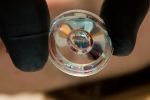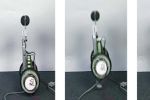Harvesting Energy From Humans
The Bionic Energy Harvester can produce enough power from a one-minute walk to juice a cell phone for 30 minutes. The generator [red] sits on your knee and gathers energy toward the end of your step, when your leg begins to brake. Greg Ehlers/SFU [inset: Claus Lunau]
The human body contains enormous quantities of energy. In fact, the average adult has as much energy stored in fat as a one-ton battery. That energy fuels our everyday activities, but what if those actions could in turn run the electronic devices we rely on? Today, innovators around the world are banking on our potential to do just that.
Movement produces kinetic energy, which can be converted into power. In the past, devices that turned human kinetic energy into electricity, such as hand-cranked radios, computers and flashlights, involved a person’s full participation. But a growing field is tapping into our energy without our even noticing it.
Consider, for example, a health club. With every step you take on a treadmill and with every bicep curl, you turn surplus calories into motion that could drive a generator and produce electricity. The energy from one person’s workout may not be much, but 100 people could contribute significantly to a facility’s power needs.
That’s the idea behind the Green Microgym in Portland, Oregon, where machines like stationary bikes harvest energy during workouts. Pedaling turns a generator, producing electricity that helps to power the building. For now, body energy supplies only a small fraction of the gym’s needs, but the amount should increase as more machines are adapted. “By being extremely energy-efficient and combining human power, solar and someday wind, I believe we’ll be able to be net-zero for electricity sometime this year,” says the gym’s owner, Adam Boesel. His bikes, by the way, aren’t the first to put pedal power to work. In some parts of the world, cyclists have been powering safety lights for years with devices called bicycle dynamos, which use a generator to create alternating current with every turn of the wheels.
Dance clubs are also getting in on the action. In the Netherlands, Rotterdam’s new Club WATT has a floor that harnesses the energy created by the dancers’ steps. Designed by a Dutch company called the Sustainable Dance Club, the floor is based on the piezoelectric effect, in which certain materials produce an electric current when compressed or bent. (The most common example is a cigarette lighter, in which a hammer causes a spark to be emitted when it strikes a piezoelectric crystal.) As clubgoers dance, the floor is compressed by less than half an inch. It makes contact with the piezoelectric material under it and generates anywhere from two to 20 watts of electricity, depending on the impact of the patrons’ feet. For now, it’s just enough to power LED lights in the floor, but in the future, more output is expected from newer technology. In London, Surya, another new eco-nightclub, uses the same principle for its dance floor, which the owners hope will one day generate 60 percent of the club’s electricity.
Popular Tags
The Environment

| regarding | user | just commented |
|---|---|---|
| Rubik 360 Will Probably Take That One Guy Another 26 Years to Solve | Ulyssus | My cube is still sitting on |
| Think You Can Land an A320 on the Hudson River? | Nick82 | All these types of games are |
| We Are What Our Parents Ate | Nick82 | If I were fat I would be |
| Take a short hop on the A380! | Nick82 | I've flown the Singapore |
| We Are What Our Parents Ate | Karl777 | This makes me feel even |
Featured
The Environment
America's 50 Greenest Cities
Want to see a model for successful and rapid environmental action? Don't look to the federal government—check out your own town. Here, our list of the 50 communities that are leading the way. Does yours make the cut?
Popular on Popsci
Most Viewed
The Environment
- Harvesting Energy From Humans
- Making the Most of **it
- Volcanoes: The Real Eco-Villains?
- Ethanol—Better Than We Thought?
- The Unbearable Lightness for Beings
- Asphalt Gets a Hot, Green Makeover
- The Science of Survival
- New York to Transform Land Strip Into Eco-Haven
- Fewer Mountain Gorillas Than Believed
- Be Eco-Friendly (Without Exhaust That Smells Like French Fries)
Most Commented
The Environment
- And Now a Look at the Weather
- The Heat is on at the Tennis
- The Unbearable Lightness for Beings
- Have Sex, Achieve Immortality
- Ethanol—Better Than We Thought?
- Harvesting Energy From Humans
- Be Eco-Friendly (Without Exhaust That Smells Like French Fries)
- Obama Puts the EPA to Work
- New York to Transform Land Strip Into Eco-Haven
- Diminishing Days for Emperor Penguins
Most Emailed
The Environment
- Be Eco-Friendly (Without Exhaust That Smells Like French Fries)
- Asphalt Gets a Hot, Green Makeover
- Volcanoes: The Real Eco-Villains?
- The Unbearable Lightness for Beings
- Making the Most of **it
- And Now a Look at the Weather
- Ethanol—Better Than We Thought?
- Harvesting Energy From Humans
- Obama Puts the EPA to Work
- The Heat is on at the Tennis








